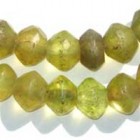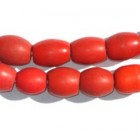
Vaseline Beads are a variety of Czech trade bead originally manufactured in Bohemia (present day Czechoslovakia) between the late 19th and early 20th century. Their name derives from their distinctive translucent yellow color – similar to that of Vaseline/ petroleum jelly. Vaseline Beads are also known as “Uranium Glass Beads” owing to the small quantities of the element used to influence their color.

Yellow Vaseline Beads
When mixed with glass, either as an oxide or in the form of salts, uranium has a tendency to alter the structural properties of the glass, causing it to glow a green-yellow color in ultra-violet light. The quantity used had a significant impact upon the color of the glass, which is why some early 19th century Vaseline Beads are almost milky white in color. The growing fascination with uranium glass influenced a period of mass production in Europe from 1905; ironically, the same point at which Bohemia held the monopoly for mass bead production.
According to trade records, Vaseline Beads were produced to demand in Bohemia for English, Italian, and Spanish merchants. The expense of producing these beads on such a massive scale was soon felt by glass-makers in Bohemia, and they set about experimenting with different quantities of Uranium to glass to determine exactly how much was needed to influence fluorescence in ultra-violet light. As it turned out, the ratio of salts to glass needed was little more than 1-2%, prompting more glass factories to begin accepting orders from European merchants. The effects of World War I and the Great Depression meant that demand for Vaseline glass declined considerably during the mid 1920s, and by the time the Communists seized power in Bohemia, Vaseline Beads were largely obsolete.
Bohemian Vaseline Beads produced during the 19th and early 20th century are distinguishable from later imitations by their cut and shape. They were commonly made in either rondelle, bicone or disc form, with distinctive hand-cut facets. Older beads tend to be milky white in appearance, while those manufactured from 1905 onwards were typically more amber-yellow in color.
References:
Uranium Glass, Wikipedia
Colodonte Beads (also known as “tomato”, “pigeon egg” and “hummingbird egg” beads) are a type of wound, drawn bead originally produced in Bohemia (now Czechoslovakia) during the 1900s. The modern nicknames given to these beads derive from the fact they bear a close resemblance in shape to the eggs of small wild birds. Early Colodonte Beads were predominantly opaque red or burnt orange in color – hence their sometimes being referred to as “tomato beads”.

Red Colodonte (Tomato) Beads
The mysterious history of Colodonte Beads has led to considerable speculation in online forums as to their intended use. The name “Colodonte” is believed to be of Italian origin; “colo” deriving from the Italian word “colore” (meaning color), and “donte”, which loosely translated means “everlasting”. However, there is no evidence to suggest that these beads were produced in Venice, lending credibility to the theory that artisans in Bohemia may have been producing them specifically for Italian merchants to use as currency overseas. The vast majority of old Colodonte Beads sold today originate from present day Mali and other coastal parts of West Africa.
Colodonte Beads are distinguishable from other Bohemian Trade Beads by their oval shape and smooth finish. The blemish free, glossy skin of the beads is similar in appearance to tomato skin – perhaps another reason they earned the moniker “tomato beads”. Nearly all trade beads of this type are round or oval in shape, however can vary in size from 20 – 40 mm in diameter. Colodonte Beads manufactured during the 19th Century typically suffer minor pitting – a tell-tale sign of their age and fascinating history.